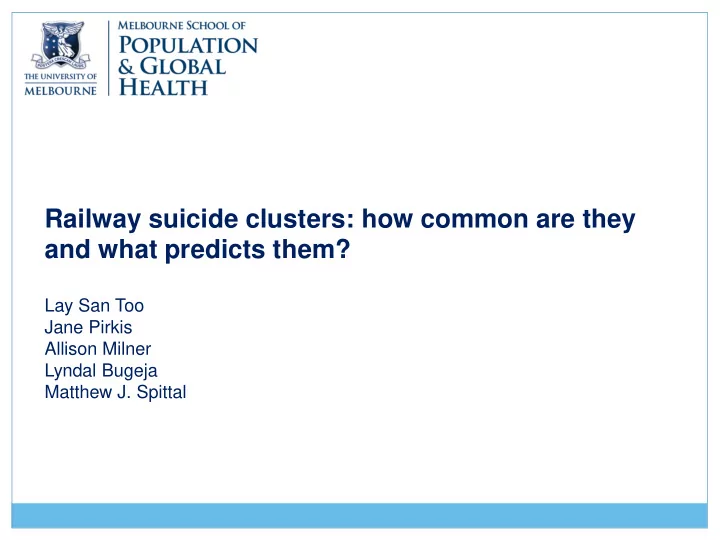

Railway suicide clusters: how common are they and what predicts them? Lay San Too Jane Pirkis Allison Milner Lyndal Bugeja Matthew J. Spittal
Overview Background Aims Significance Methods Results Conclusions
What is suicide cluster? It is defined as unusually high numbers of suicidal behaviours occurring closer together in space and/or time than would be typically expected. Temporal cluster (mass cluster) It occurs comparatively close in time across varied locations. Spatial cluster It occurs within a small geographical area, not bounded by time. Spatial-temporal cluster (point cluster) It occurs in close temporal and geographical proximity to each other.
Burden of railway suicide and its cluster Adverse consequences of railway suicide • Traumatic effects on family and friends as well as witnesses to the incident, including train drivers, other railway staff, and passengers. • Financial loss to railway companies. Problems of railway suicide cluster • Cumulative impact on these witnesses. • Confer a risk of copycat acts.
Past research Existing evidence • Suicides were not distributed randomly on the railway network; rather, there were distinct areas on the network where clusters occurred. • These areas tended to located close to mental health institutions. Limitation of past studies • They relied on “rule -of- thumb” definitions of a cluster rather than using a definition that accounts for the underlying suicide rate in the population. The scan statistics (SaTScan) • Increasingly being used to detect suicide clusters. • Considers the population size and the rate of the problem of interest. References: Krysinska & De Leo, 2008; Debbaut, Krysinska, & Andriessen, 2013; Emmerson & Cantor, 1993; O'Donnell & Farmer, 1993; Mishara, 2007
Aims 1) To identify clusters of railway suicides occurring closer in time, space, or both time and space using the scan statistics. 2) To investigate potential individual and neighbourhood factors that might be associated with a given railway suicide being part of a cluster.
Significance • If clusters of railway suicides are identified, it can offer some clues as to where railway suicide prevention efforts should be focused.
Methods: setting, period, & data sources Study setting: Victoria, Australia. Study period: 1 Jan 2001 & 31 Dec 2012. Railway suicide data Sources: National Coronial Information System & Coroners Court of Victoria. Inclusion: Intentional self-harm by rail vehicle. Exclusion: 1) still under investigation; 2) missing residential postcode; 3) resided outside Victoria; or 4) died after being hit by a tram.
Methods: cluster detection To detect spatial, temporal and spatial-temporal cluster Poisson discrete scan statistic (SaTScan) • Information on cases, area population estimates and area coordinates. • Spatial window: 4.17% of the total population at risk. • Spatial window shape: circular. • Temporal window: 1-12 months. • Monte Carlo stimulation: significant cluster ( p-value < 0.05).
Methods: identification of associated factors To identify the factors associated with a railway suicide being in a cluster Case-control design • Cases: clustered railway suicide • Controls: non-clustered railway suicide
Methods: exposure variables Individual variable Data year Data sources Sex 2001-2012 NCIS & CCOV Age NCIS & CCOV 2001-2012 Marital status NCIS & CCOV 2001-2012 Employment status NCIS & CCOV 2001-2012 Diagnosed mental illness NCIS & CCOV 2001-2012 Mental health hospitalisation history NCIS & CCOV 2001-2012 NCIS, National Coronial Information System; CCOV, Coroners Court of Victoria
Methods: exposure variables Neighbourhood variable Data year Data sources Presence of railway tracks 2009-2012 Geoscience Australia, MTM, V/Line Train frequency 2012 VicTrack Train speed 2014 VicTrack Number of surveillance units 2009-2012 PTV, MTM Number of level crossing 2014 VicTrack Number of stations 2009-2012 PTV, V/Line People who travel to work by train (%) 2011 ABS Census Number of station patronage 2009-2012 PTV, MTM Number of pedestrian 2014 VicTrack MTM, Metro Trains Melbourne; PTV, Public Transport Victoria
Methods: exposure variables Neighbourhood variable Data year Data sources Social fragmentation 2001, 2006, 2011 ABS census Socioeconomic deprivation 2001, 2006, 2011 ABS census • Index of Relative Socio-economic Disadvantage • Index of Economic Resources Number of assaults 2001-2012 Victoria Police Statistics Alcohol outlets density 2001-2012 Victorian Commission for Gambling and Liquor Regulation Number of mental health services 2014 Mental Health, Drugs & Regions (Victorian Government Department of Health) Number of secondary schools 2015 Department of Education and Early Childhood Development Overall suicide rate 2001-2012 NCIS, ABS
Methods: statistical analysis Logistic regression model • Univariate analysis • Multivariate analysis, controlling for known confounders • Stata 13.1
Results: cluster detection & characteristics • Four spatial clusters. o 35% of all railway suicides (120/347). o Cluster size: from 23 to 38 suicides. o All clusters in urban area. o Five mental health institutions (inpatient treatments). o Contained sections of 7 train lines. o 66% occurred on open tracks, 16% in station areas, 9% at level crossings, 9% at pedestrian crossings • No temporal and spatial-temporal clusters.
Results: multivariate analysis Variable Adjusted OR 95% CI p-value Individual-level Mental health hospitalisation 0.015 Current inpatient 0.61 0.19-2.00 Past inpatient 2.00 1.15-3.46 Never inpatient 1.00 Neighbourhood-level Train frequency 1.07 1.00-1.15 0.037 Number of stations 1.05 0.66-1.69 0.828 % People who travel to work 1.01 0.96-1.07 0.619 by train Index of Economic Resources 0.96 0.82-1.14 0.658
Conclusions Railway suicides can occur in clusters, particularly when individuals have had previous hospitalisations for mental illness and/or live in areas with a high frequency of train services. A response to railway suicide clusters is required. Possible interventions: • Limiting access to the railways; • Increasing surveillance at cluster locations. References: Cox et al., 2013; Pirkis et al. (2015)
Thank you for listening.
Recommend
More recommend